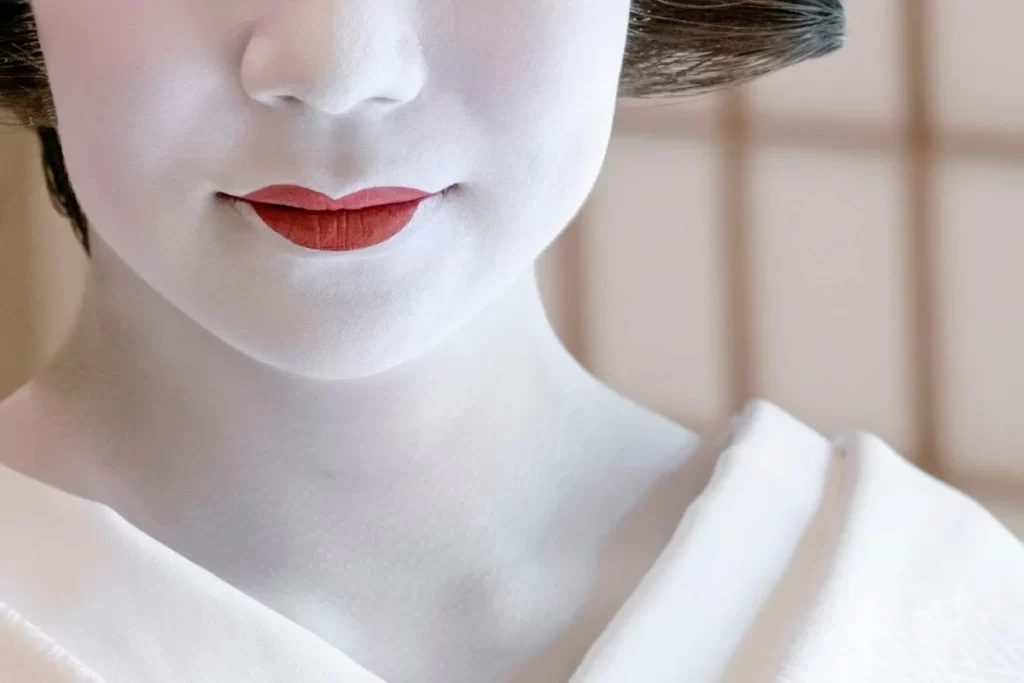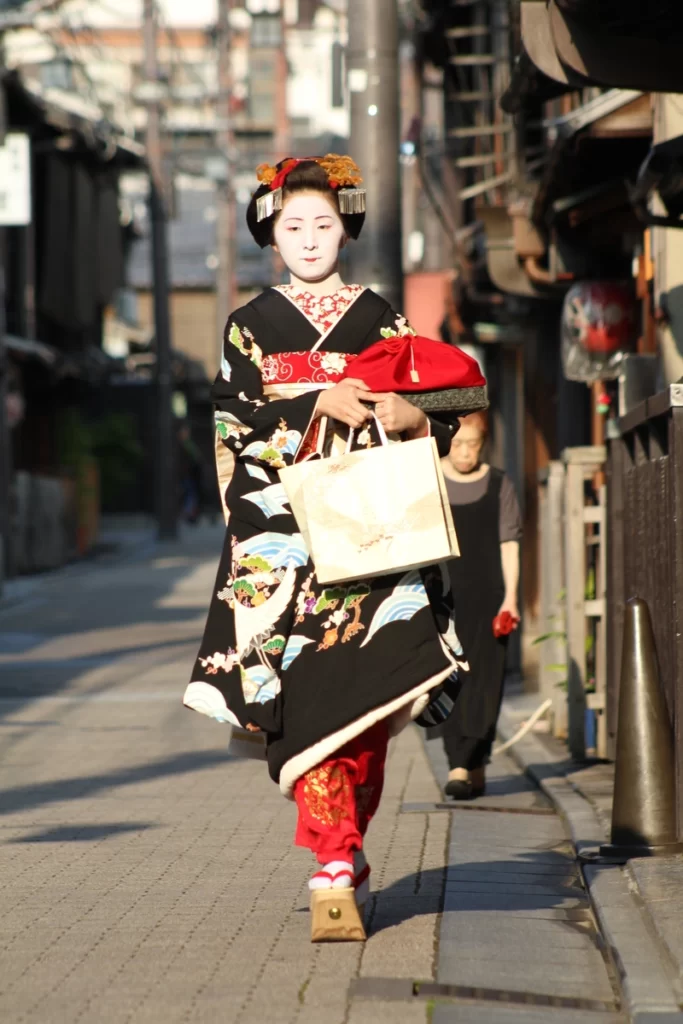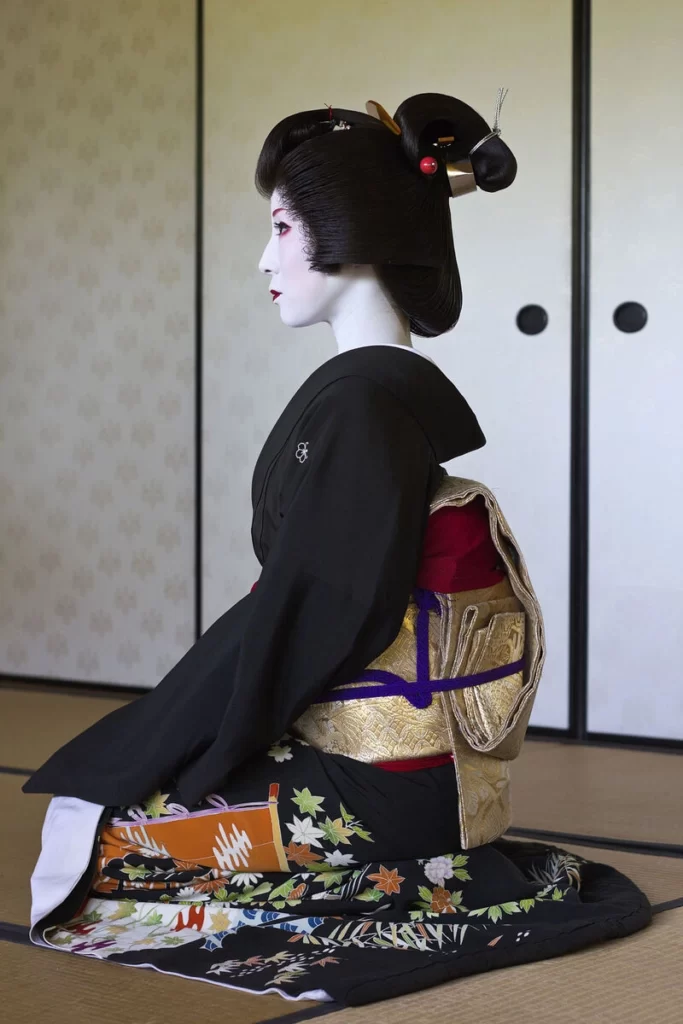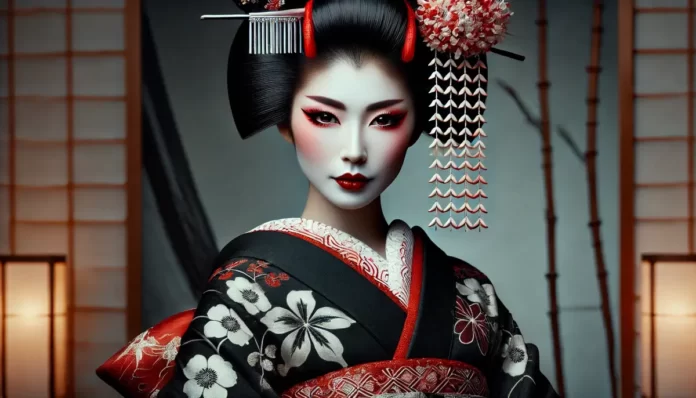The intricate beauty of Geisha costumes and traditional Geisha makeup is more than mere decoration; it represents centuries of cultural symbolism and artistry.
From the vibrant kimonos to the signature white makeup, every element serves a purpose, reflecting the grace, status, and artistry of geishas.
This article explores the deeper meanings behind these iconic elements, shedding light on how they connect to Japanese traditions and the role they play in the life of a geisha.
The Symbolism of Geisha Costumes
Geisha costumes, particularly their kimonos, are a visual language of elegance and status. These garments are crafted with meticulous attention to detail and hold significant meaning.
- Kimono Designs: The patterns and colors on a geisha’s kimono often reflect the seasons or specific events. For example, cherry blossoms signify spring, while maple leaves are a nod to autumn.
- Obi (Sash): The way the obi is tied can indicate whether the wearer is a maiko (apprentice) or a full-fledged geisha. Maiko often wear elaborate, long obis, while geishas opt for simpler, more mature styles.
- Fabric and Craftsmanship: High-quality silk and intricate embroidery emphasize the luxury and artistry of Geisha costumes, symbolizing refinement and cultural pride.
Example: A maiko’s kimono often features bold, vibrant colors with floral motifs, showcasing her youthful status.
You Might also like: Geisha-Inspired Beauty and Fashion: Global Industry Trends
The Art of Traditional Geisha Makeup

The distinct traditional Geisha makeup is not only a hallmark of their appearance but also a cultural tradition steeped in symbolism.
- White Foundation: The iconic white makeup represents purity and a canvas for the art of geisha. It also highlights facial expressions under dim lighting, making performances more impactful.
- Red and Black Accents: Red lips and eyeliner symbolize youth, passion, and elegance, while the subtle use of black adds contrast and definition.
- Neck and Nape Painting: The nape of the neck is left bare or painted with intricate designs, considered one of the most alluring features in geisha culture.
Example: A maiko’s makeup is more elaborate, with bright colors and detailed patterns, while a geisha’s is understated to reflect maturity.
Key Differences Between Maiko and Geisha Styles
The transition from maiko (apprentice) to geisha (fully-fledged artist) is not only a journey of skill and experience but also a visual transformation reflected in their costumes and makeup.
Each stage in their progression tells a story of growth, maturity, and changing roles within the geisha community.
Maiko Style: Bold and Vibrant

A maiko’s appearance is designed to emphasize her youthful energy and vibrancy. Every aspect of her costume and makeup reflects her position as an apprentice learning the art of being a geisha.
Costumes:
- Kimono Design: Maiko wear colorful and elaborate kimonos adorned with bold patterns, such as cherry blossoms, cranes, or seasonal motifs. These designs are intended to capture attention and showcase their youthful exuberance.
- Sleeves: The sleeves (furisode) of a maiko’s kimono are much longer than those of a geisha, symbolizing her unmarried status and youthful elegance.
- Obi (Sash): Maiko wear long, ornate obis that are intricately tied at the back into elaborate shapes, often resembling a butterfly or drum. The length and complexity of the obi are a hallmark of the maiko’s style.
Hair and Accessories:
- Maiko style their natural hair into traditional hairstyles, such as the wareshinobu, which is decorated with vibrant hair ornaments (kanzashi) made of flowers, beads, or ribbons.
- The ornaments often change with the seasons or reflect the stage of their apprenticeship.
Makeup:
- Foundation: A thick white foundation covers the face, neck, and chest, emphasizing their youthful glow.
- Accents: The red and black accents around the eyes and eyebrows are exaggerated, creating a dramatic and playful look.
- Lips: Only the lower lip is painted red during the initial stages of training, signifying their apprentice status.
Geisha Style: Subdued and Elegant

As a maiko transitions to a geisha, her style evolves to reflect maturity, grace, and understated sophistication. The emphasis shifts from vibrancy to refined simplicity.
Costumes:
- Kimono Design: Geisha wear kimonos with more subdued colors and patterns, often featuring smaller, elegant designs such as subtle floral motifs or geometric patterns.
- Sleeves: The sleeves of a geisha’s kimono are shorter and more practical, reflecting her transition to a professional role.
- Obi (Sash): The obi becomes simpler in design and shorter in length, tied in a more understated style to signify her maturity and status.
Hair and Accessories:
- Geisha switch from styling their natural hair to wearing wigs (katsura), which are easier to maintain and create a consistent appearance.
- Hair ornaments are more modest, often featuring gold or silver accents to match their mature image.
Makeup:
- Foundation: The white makeup is less prominent, often limited to special occasions or performances. On casual days, a natural complexion is preferred.
- Accents: The eye makeup is softer, with minimal use of red and black around the eyes.
- Lips: Both lips are fully painted in a more subdued red, reflecting elegance and experience.
The Significance of the Transformation
This progression in style from maiko to geisha signifies more than just age or experience—it reflects the geisha’s journey toward mastery of her craft.
- Maiko: Their bold and elaborate appearance is meant to captivate and attract attention, highlighting their youthful enthusiasm as they learn the traditions of geisha life.
- Geisha: Their refined and minimalist style conveys confidence, maturity, and the grace of an artist who has mastered her role.
The visual differences between maiko and geisha styles not only represent individual growth but also ensure that their cultural roles are instantly recognizable within Japanese society.
This transformation is a vital part of the artistry and tradition that defines geisha culture.kill and social status within the geisha community.
Cultural Significance of Geisha Costumes and Makeup
The importance of Geisha costumes and traditional Geisha makeup goes beyond aesthetics.
- Cultural Preservation: These elements are a testament to Japan’s dedication to preserving its artistic heritage.
- Storytelling: Through their attire and makeup, geishas tell stories and evoke emotions during performances.
- Symbol of Refinement: Both their costumes and makeup serve as symbols of discipline, grace, and the meticulous training required to become a geisha.
Conclusion
The beauty of Geisha costumes and traditional Geisha makeup lies not only in their visual appeal but also in their deep cultural and symbolic meanings.
From the intricate patterns of kimonos to the artistry of their makeup, every detail reflects centuries of tradition and the role of geishas as cultural ambassadors.
By understanding the significance of these elements, we gain a deeper appreciation for the artistry and dedication that define geishas and their enduring legacy in Japanese culture.








